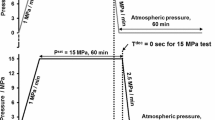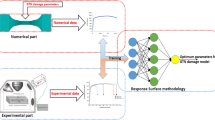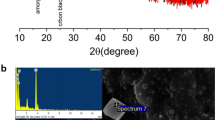Abstract
The effect of repeated high-pressure hydrogen cycles on the decompression failure of unfilled EPDM was investigated from in-situ images of the damage field during decompression. The purpose was to characterize the relative influence of some parameters of the pressure cycle (decompression rate, residual pressure and time between two cycles) and to investigate damage cumulative features. Beyond that, the aim of this wide range of decompression conditions was to separately vary the external pressure and gas diffusion histories, in order to discuss them as driving force contributions to damage growth. Such extended decompression conditions confirmed coupled contributions of diffusion and mechanics. Exposure conditions allowing a significant part of gas diffusion promoted clustering and later macro-cracking, provided that the residual external pressure was low enough. A more heterogeneous spatial distribution of damage was also observed, within clusters and at the sample scale, with non-trivial re-opening of cavities from one cycle to another. More restrictive exposure conditions (i.e., limited diffusion times or residual external pressure) reduced or prevented the onset of cavities, clustering and transition to macro-cracking. More homogeneous damage fields were observed, along with more systematic re-appearing and growth of the same defects with cycling. Damage processes appeared more spatially confined.













Similar content being viewed by others
References
Briscoe BJ, Savvas T, Kelly CT (1994) Explosive decompression failure of rubbers: a review of the origins of pneumatic stress induced rupture in elastomers. Rubber Chem Technol 67(3):384–416
Campion RP (1990) Explosive decompression in elastomers—Internal blistering and fracturing in rubbers after high-pressure exposure to gases. Cell Polym 9:206–228
Fazal M, Castagnet S, Nait–Ali A, Nishimura S (2020) Local kinetics of cavitation in hydrogen−exposed EPDM using in situ X−Ray tomography: focus on free surface effect and cavity interaction. Polym Test 91:106723
Gent AN, Tompkins DA (1969) Nucleation and growth of gas bubbles in elastomers. J Appl Phys 40(6):2520–2525
Jaravel J, Castagnet S, Grandidier JC, Benoit G (2011) On key parameters influencing cavitation damage upon fast decompression in a hydrogen saturated elastomer. Polym Testing 30(8):811–818
Jeon SK, Kwon OH, Tak NH, Chung NK, Baek UB, Nahm SH (2022) Relationships between properties and rapid gas decompression (RGD) resistance of various filled nitrile butadiene rubber vulcanizates under high-pressure hydrogen. Mater Today Commun 30:103038
Kane-Diallo O, Castagnet S, Nait-Ali A, Benoit G, Grandidier JC (2016) Time-resolved statistics of cavity fields nucleated in a gas-exposed rubber under variable decompression conditions–support to a relevant modeling framework. Polym Test 51:122–130
Koga A, Uchida K, Yamabe J, Nishimura S (2011) Evaluation on high-pressure hydrogen decompression failure of rubber O-ring using design of experiments. Int J Autom Eng 2(4):123–129
Kulkarni SS, Choi KS, Kuang W, Menon N, Mills B, Soulami A, Simmons K (2021) Damage evolution in polymer due to exposure to high-pressure hydrogen gas. Int J Hydrogen Energy 46:19001–19022
Kumar A, Lopez-Pamies O (2021) The poker-chip experiments of Gent and Lindley (1959) explained. J Mech Phys Solids 150:104359
Lefevre V, Ravi-Chandar K, Lopez-Pamies O (2015) Cavitation in rubber: an elastic instability or a fracture phenomenon? Int J Fract 192:1–23
Morelle X, Sanoja GE, Castagnet S, Creton C (2021) 3D fluorescent mapping of invisible molecular damage after cavitation in hydrogen exposed elastomers. Soft Matter R Soc Chem 17(16):4266–4274
Najipoor M, Haroonabadi L, Dashti A (2018) Assessment of failures of nitrile rubber vulcanizates in rapid gas decompression (RGD) testing: effect of physico-mechanical properties. Polym Test 72:377–385
Ono H, Nait-Ali A, Kane-Diallo O, Benoit G, Castagnet S (2018) Influence of pressure cycling on damage evolution in an unfilled EPDM exposed to high-pressure hydrogen. Int J Fract 210(1–2):137–152
Pepin J, Laine E, Grandidier JC, Castagnet S, Blanc-vannet P, Papin P, Weber M (2018) Determination of key parameters responsible for polymeric liner collapse in hyperbaric type IV hydrogen storage vessels. Int J Hydrogen Energy 43:16386–16399
Schrittesser B, Pinter G, Schwarz Th, Kadar Z, Nagy T (2016) Rapid gas decompression performance of elastomers—a study of influencing testing parameters. Procedia Struct Integrity 2:1746–1754
Yamabe J, Nishimura S (2009) Influence of fillers on hydrogen penetration properties and blister fracture of rubber composites for O-ring exposed to high-pressure hydrogen gas. Int J Hydrogen Energy 34:1977–1989
Yamabe J, Nishimura S (2011) Nanoscale fracture analysis by atomic force microscopy of EPDM rubber due to high-pressure hydrogen decompression. J Mater Sci 46:2300–2307
Yamabe J, Nishimura S (2013) Failure behavior of rubber O-ring under cyclic exposure to high-pressure hydrogen gas. Eng Fail Anal 35:193–205
Acknowledgements
Authors are grateful to Pr. S. Nishimura from Kyushu University (Japan) for kindly providing the material of this study. Pprime Institute gratefully acknowledges "Contrat de Plan Etat—Région Nouvelle-Aquitaine" (CPER) as well as the "Fonds Européen de Développement Régional (FEDER)" for their financial contribution to the devices used in this work.
Funding
This work was partially funded by the French Government program “Investissements d’Avenir” LABEX INTERACTIFS (reference ANR-11-LABX-0017–01) and EUR INTREE (reference ANR-18-EURE-0010). It pertains to the scope of the French Research Network on Hydrogen energy (FRH2), FR CNRS 2044, (https://frh2.cnrs.fr/).
Author information
Authors and Affiliations
Corresponding author
Ethics declarations
Competing interest
The authors declare that they have no known competing financial interests or personal relationships that could have appeared to influence the work reported in this paper.
Additional information
Publisher's Note
Springer Nature remains neutral with regard to jurisdictional claims in published maps and institutional affiliations.
Rights and permissions
Springer Nature or its licensor (e.g. a society or other partner) holds exclusive rights to this article under a publishing agreement with the author(s) or other rightsholder(s); author self-archiving of the accepted manuscript version of this article is solely governed by the terms of such publishing agreement and applicable law.
About this article
Cite this article
Ono, H., Nait-Ali, A. & Castagnet, S. Damage evolution in unfilled EPDM during various types of repeated hydrogen high-pressure cycles. Int J Fract 242, 153–167 (2023). https://doi.org/10.1007/s10704-023-00707-w
Received:
Accepted:
Published:
Issue Date:
DOI: https://doi.org/10.1007/s10704-023-00707-w




